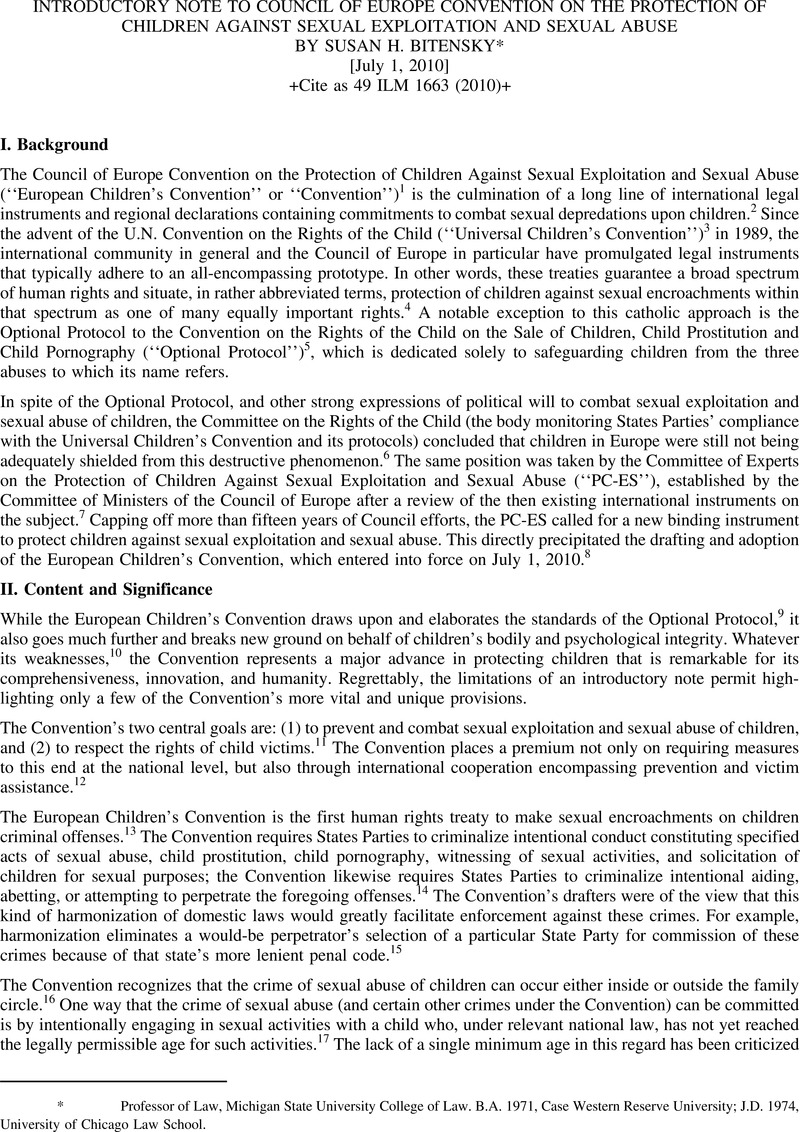Published online by Cambridge University Press: 27 February 2017

* This text was reproduced and reformatted from the text available at the Council of Europe website (visited Nov. 28, 2010) http://conventions.coe.int/Treaty/EN/treaties/Html/201.htm.
1 Council of Europe Convention on the Protection of Children Against Sexual Exploitation and Sexual Abuse, opened for signature Oct. 25, 2007, C.E.T.S. 201 (entered into force July 1, 2010) [hereinafter European Children’s Convention].
2 International legal instruments extending protections against various types of sexual victimization of children include, for example, the following: Council of Europe Convention on Action Against Trafficking in Human Beings art. 4, ¶ c, done May 16, 2005, E.T.S. No. 197 (providing special protection to children against trafficking in human beings); Council of Europe Convention on Cybercrime art. 9, opened for signature Nov. 23, 2001, C.E.T.S. No. 185 [hereinafter Cybercrime Convention] (listing offenses related to child pornography); Convention on the Rights of the Child arts. 11, 19, ¶ 1; arts. 34-36, adopted and opened for signature Nov. 20, 1989, 1577 U.N.T.S. 3 (entered into force Sept. 2, 1990) [hereinafter Universal Children’s Convention] (safeguarding children from illicit transfers and trafficking, sexual abuse, and sexual exploitation). Regional declarations articulating positions against sexual assaults on children include the following: First World Congress Against Commercial Sexual Exploitation of Children, Stockholm Declaration and Agenda for Action, Aug. 27-31, 1996, available at http://www.csecworldcongress.org/PDF/en/Stockholm/Outome_documents/Stockholm%20Declaration%201996_EN.pdf; Council of Europe, Recommendation (2001) 16 of the Committee of Ministers to Member States on the Protection of Children Against Sexual Exploitation, Oct. 31, 2001, available at https://wcd.coe.int/ViewDoc.jsp?id=234247.
3 Universal Children’s Convention, supra note 2.
4 See, e.g., id.; European Social Charter (Revised), opened for signature May 3, 1996, 2151 U.N.T.S. 277.
5 Optional Protocol to the Convention on the Rights of the Child on the Sale of Children, Child Prostitution and Child Pornography, adopted and opened for signature May 25, 2000, G.A. Res. 54/263, U.N. Doc. A/54/263 (Jan. 18, 2002) [hereinafter Optional Protocol].
6 Council of Europe, Explanatory Report on the Council of Europe Convention on the Protection of Children Against Sexual Exploitation and Sexual Abuse ¶ 7 (July 12, 2007), available at http://conventions.coe.int/Treaty/EN/Reports/Html/201.htm [hereinafter Explanatory Report].
7 Id. ¶¶ 22, 30-32.
8 European Children’s Convention, supra note 1.
9 Holly Cullen, The Nature of State Obligations in Relation to Child Labour: Choosing Prosecution Over Protection, in International Law and Power: Perspectives on Legal Order and Justice: Essays in Honour of Colin Warbrick 99, 104 (Kaiyan Homi Kaikobad & Michael Bohlander eds., 2009).
10 For an assessment of some of the purported strengths and weaknesses of the European Children’s Convention, see National Society for the Prevention of Cruelty to Children [NSPCC], Council of Europe Convention on the Protection of Children Against Sexual Exploitation and Sexual Abuse: Briefing for Policy Makers (Sept. 2007), http://www.nspcc.org.uk/Inform/policyandpublicaffairs/Europe/Briefings/councilofeurope_wdf51232.pdf.
11 European Children’s Convention, supra note 1, art. 1, ¶ 1a-b;Explanatory Report, supra note 6, ¶ 37.
12 European Children’s Convention, supra note 1, art. 1, ¶ 1c; chs. II-IX; Explanatory Report, supra note 6, ¶¶ 38-39.
13 Council of Europe, Summary of the Council of Europe Convention on the Protection of Children Against Sexual Exploitation and Sexual Abuse, http://conventions.coe.int/Treaty/EN/Summaries/Html/201.htm.
14 European Children’s Convention, supra note 1, arts. 18-24. It should be noted that the Convention gives States Parties discretion not to criminalize domestically some Convention offenses coming within the ambit of the crimes listed in the text above. See, e.g., European Children’s Convention, supra note 1, art. 20, ¶ 4 (giving each party the right not to apply the crime of knowingly obtaining access, through information and communication technologies, to child pornography).
15 Explanatory Report, supra note 6, ¶ 112.
16 See, e.g., European Children’s Convention, supra note 1, art. 18, ¶ 1b; Explanatory Report, supra note 6, ¶¶ 120, 123-25.
17 European Children’s Convention, supra note 1, art. 18, ¶ 1a.
18 See Kalen Fredette, International Legislative Efforts to Combat Child Sex Tourism: Evaluating the Council of Europe Convention on Commercial Child Sexual Exploitation, 32 B.C. Int’l & Comp. L. Rev. 1, 36 (2009).
19 See, e.g., European Children’s Convention, supra, note 1, art. 20, ¶ 1f; art. 23.
20 Explanatory Report, supra note 6, ¶ 133.
21 European Children’s Convention, supra note 1, art. 23; Explanatory Report, supra note 6, ¶¶ 155, 159.
22 Explanatory Report, supra note 6, ¶¶ 155-56. See generally Suzanne Ost, Child Pornography and Sexual Grooming: Legal and Societal Responses 32-53, 70-102 (2009).
23 European Children’s Convention, supra note 1, art. 25, ¶ 1ac; Explanatory Report, supra note 6, ¶¶ 166-67.
24 European Children’s Convention, supra note 1, art. 25, ¶ 1d; Explanatory Report, supra note 6, ¶ 168.
25 European Children’s Convention, supra note 1, art. 25, ¶ 4, Explanatory Report, supra note 6, ¶ 171.
26 Fredette, supra note 18, at 34.
27 European Children’s Convention, supra note 1, art. 1, ¶ 1a; arts. 4-9.
28 Id. chs. IV, VII.
29 Id. art. 14, ¶ 1.
30 Explanatory Report, supra note 6, ¶ 94.
31 European Children’s Convention, supra note 1, art. 30, ¶¶ 1-3; arts. 31-36.
32 European Children’s Convention, supra note 1, art. 33; Explanatory Report, supra note 6, ¶ 231.
33 E.g., European Children’s Convention, supra note 1, art. 9, ¶ 1; art. 14, ¶ 1.
34 Id. art 9, ¶ 1.
35 See Corinne May-Chahal & Maria Herczog, Introduction and Overview of Child Sexual Abuse in Europe, in Child Sexual Abuse in Europe 3, 10-13 (Corinne May-Chahal & Maria Herczog coordinators, 2003) (noting the intransigence and prevalence of child sexual abuse in Europe); Fredette, supra note 18, at 6-8 (discussing that patrons of child sex tourism frequently travel to countries prone to hosting this activity); Explanatory Report, supra note 6, ¶¶ 1-3 (describing the pervasiveness of sexual crimes against children and the difficulties that children may confront vis-a`-vis reporting the occurrence of these crimes).
36 Explanatory Report, supra note 6, ¶¶ 24-25.
37 Fredette, supra note 18, at 43.
1 Date on which the Convention entered into force.